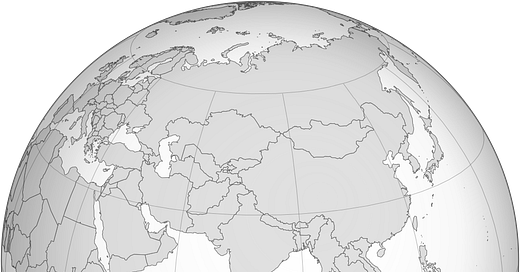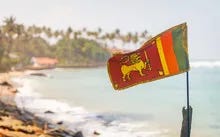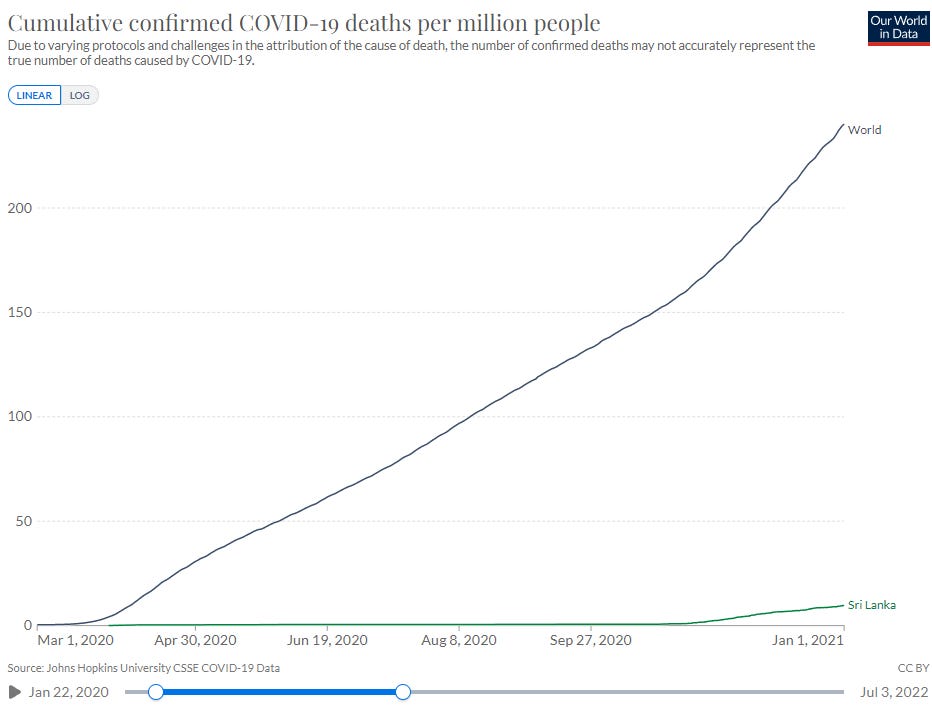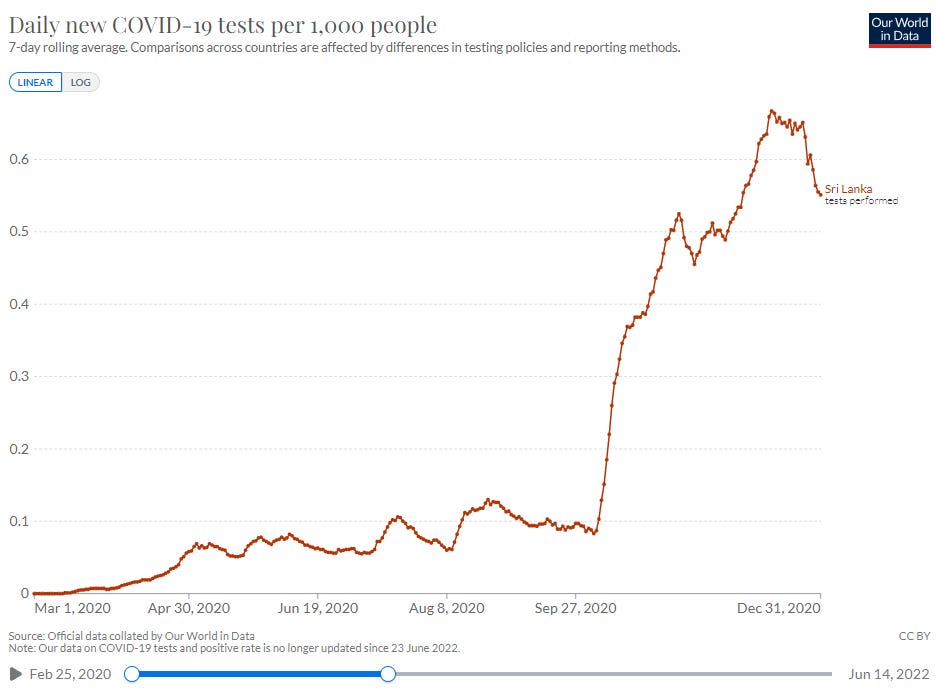“Only the cure you believe in cures.” -Sri Lankan proverb
Other Pandemic National Case Studies can be found here.
The largely Buddhist nation of Sri Lanka enjoyed one of the world’s fastest rates of economic growth for four decades leading up to the COVID-19 pandemic. So too have health standards sharply improved for the South Asian Island. At the turn of the 20th century, life expectancy in Sri Lanka sat barely above 30, but has reached parity with that of the U.S. in recent years. These improvements are owed to a commitment to education which has resulted in a 99% youth literacy rate and rapidly increasing computer literacy.
The former British Crown Colony, also known as the Teardrop of India, become a Republic 50 years ago in May, and named its ten-syllable capital Sri Jayawardenepura Kotte, probably to ensure that most of the British would have little chance at successfully ordering a ticket to get there from any airport.
Credit: Connormah via CC BY-SA 3.0
While Sri Lanka’s government talked up public health measures (after receiving hundreds of millions in grants and loans from both China and the World Bank), Sri Lanka imported hydroxychloroquine (HCQ) from India for use during the early going of the pandemic. Sometimes it’s hard to look under the hood to see what’s really driving an engine.

Later in 2020, Sri Lanka also made use of ivermectin to combat COVID-19.


Through 2020, Sri Lanka outperformed nearly every nation in the world of substantial size at keeping COVID-19 deaths low.
When COVID-19 deaths did start to trickle upward in October 2020, this may be entirely attributable to increases in testing. For those who are unaware, false positive rates are highest in geographies where infection rates are lowest. Obviously, where there is no infection, 100% of positive test results are false positives. So, it’s not clear that many of the 204 total deaths (merely 9 per million residents) who died “with a positive test” actually died of COVID-19.
One scholarly paper describing Sri Lanka’s public health measures failed to examine HCQ usage during the pandemic (Erandi et al, 2020). In fact, the authors never mentioned HCQ or other antivirals a single time, much less reverse-engineered something like a false positive background rate. And yet, they spent a large portion of the paper modeling outcomes with spiffy, if relatively meaningless differential equations that neither account for any medications used, nor attempt at measuring any of the various forms of prior immunity that might relate to the ability of SARS-CoV-2 to penetrate communities.
During nationwide lockdowns and port closures, the Sri Lankan government assured the people that no food shortage was imminent and that steps were being taken to cultivate food locally to make up for shortfalls. We’ll come back to this.
While Sri Lanka handled the early pandemic extremely well, the Sri Lankan government took the opportunity to crack down on civil rights, arresting people for sharing information about the pandemic that did not fit officially approved narratives. Meanwhile, the Sri Lankan government took in $128 million in support from the World Bank while sending a message that COVID-19 was bound to hit South Asia hard. Any day now.
Sri Lanka’s Tale of Mass Vaccination
Despite suffering a small COVID-19 caseload in 2020, Sri Lanka approved vaccines Pfizer/BioNTech, Moderna, Oxford/AstraZeneca, Sinopharm, Covishield, and Sputnik V. Sinopharm accounted for 78% of doses administered through late July of 2021 after a vaccine manufacturing plant producing the AstraZeneca vaccine burned down.
Despite some countries raised concerns over the Sinopharm, researchers from Sri Jayewardenepura University have found that 85 percent of vaccinees developed anti-bodies including against the Indian Delta variant.
However the presence of anti-bodies is not the same as efficacy measured in a clinical trial.
Though Sri Lanka’s experimental mass vaccination program began on January 29 of last year, the vast majority of doses were administered during the five months from early May through September—the cold season in the Southern Hemisphere.
From the start of May to through the end of October, Sri Lanka saw a tremendous spike in COVID-19 cases and deaths—more than 20-fold the cumulative numbers of deaths it saw during the first 14 months of the pandemic combined.
The vaccination program proved so bad in Sri Lanka that vaccine partisans seem to have stopped wanting to update most of the material on the “COVID-19 vaccination in Sri Lanka” Wikipedia page (last edit August 10, 2021).
Source: Dinuka Liyanawatte/ Reuters
In the meantime, despite food security issues and a looming debt crisis, Sri Lankan President Gotabaya Rajapaksa, who is controversial for installing members of his family to top government positions when he took office in 2019, inexplicably committed to a green/organic farming “experiment”, banning nitrogen-chemical fertilizers. The result has been a total disaster.

In April, Sri Lanka went into default on all its foreign debt for the first time in its history. Now the nation faces hyperinflation and severe gas shortages and transport shutdowns as the world shuffles supply chain vectors.

The 73-year old Rajapaksa vows to finish his term of office despite students mobbing his home in protest back in April. Meanwhile, COVID-19 deaths have all but disappeared in Sri Lanka during the Winter of 2022. Then again, so have the vaccines as less than 1% of the population has received a dose since those student protests.












So, according to the WEF, Sri Lanka went perfectly according to plan:
* Economic chaos: check
* Collapse of government: check
* Debt leverage: check
* Social unrest: check
* No food: check
* No fuel: check
* No jobs: check
* Military in the streets: check
It’s all coming together in Sri Lanka.
This breaks my heart so badly. I adored the Sri Lankan people when I was there. The kindest, most intelligent people you'll ever meet. They turned their beautiful land into an oasis after so much hardship and even eradicated malaria. Just can't even stand the side effects of these psychopaths and their retarded ideas to clean up the world of men.